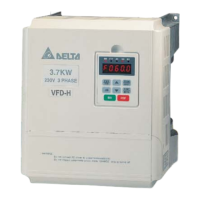How to troubleshoot OFF POWER LED on Delta DC Drives?
- JJacqueline HowardAug 10, 2025
If the POWER LED is off, it indicates no power. Check if the connection between the CMM-PD02 and the AC motor drive is normal.

How to troubleshoot OFF POWER LED on Delta DC Drives?
If the POWER LED is off, it indicates no power. Check if the connection between the CMM-PD02 and the AC motor drive is normal.
What to do if the Delta DC Drives NET LED flashes orange?
If the NET LED flashes orange, it means that the CMM-PD02 fails to communicate with the AC motor drive. To solve this, switch off the power and check whether the CMM- PD02 is correctly installed and normally connected to the AC motor drive.
Why is the NET LED on my Delta VFD25AMS23ANSAA DC Drives red?
A red light on the NET LED indicates that the CMM-PD02 is not connected to the PROFIBUS DP bus. To resolve this, connect the CMM-PD02 to the PROFIBUS DP bus.
What to do if the Delta VFD25AMS23ANSAA DC Drives NET LED flashes red?
If the NET LED flashes red, it signifies an invalid PROFIBUS communication address. To fix this, set the PROFIBUS address of the CMM-PD02 between 1–125 (decimal).
| Rated Output Current | 25A |
|---|---|
| Power Rating | 5.5 kW |
| Horsepower | 7.5 HP |
| Protection Level | IP20 |
| Input Voltage | 230V |
| Output Voltage | 0-230V |
| Control Method | V/f Control |
| Protection Features | Over-voltage, Over-current, Overload, Overheat, Low-voltage, Short circuit, Ground fault |
| Communication Interface | RS-485 (Modbus ASCII/RTU) |
| Cooling Method | Fan Cooling |
| Operating Temperature | -10°C ~ +50°C |
| Storage Temperature | -20°C ~ +60°C |
| Humidity | 90% RH, non-condensing |
| Altitude | 1000 m (derating may be required above 1000 m) |
Summarizes general specifications including control characteristics, protection characteristics, accessories, and certifications.
Details environmental conditions for operation, storage, and transportation, including temperature, humidity, air pressure, and pollution level.
Provides derating curves and tables for ambient temperature, altitude, and carrier frequency.
Describes the KPMS-LE01 keyboard panel, including its main display area, keypad functions, and descriptions.
Illustrates keypad operation processes for main page selection, setting parameters, shifting data, and PLC settings.
Summarizes drive parameters, including AC motor drive identity code and rated current display.
Details basic parameters for motors 1-4, including maximum operation frequency, rated frequency, and voltage.
Explains digital input/output parameters, including two-wire/three-wire operation control and multi-function input/output commands.
Details analog input/output parameters, including AVI and ACI selection, bias, gain, filter time, and addition function.
Lists parameters for multi-step speed settings, including frequencies for steps 1-15 and PLC buffers.
Details protection parameters including low voltage level, over-voltage and over-current stall prevention, and over-torque detection.
Explains special parameters like software brake chopper, DC brake settings, and fan cooling control.
Details high-function PID parameters, including terminal selection, proportional gain, integral time, and differential time.
Summarizes communication parameters, including address, transmission speed, fault treatment, protocol, and block transfer settings.
Details parameters for speed feedback control, including MI7 pulse input, electrical gear, and FOC bandwidth settings.
Covers advanced parameters like system control, inertia setting, ASR/ASR2 switch frequency, and torque limits.
Details protection parameters related to output frequency, DC bus voltage, output current, and IGBT temperature malfunctions.
Lists CANopen fault codes with their corresponding display, fault name, description, and CANopen fault register.
Details the steps for connecting the drive to the PC and starting PLC operation via the digital keypad.
Explains the schematic diagram for PLC ladder program scanning and introduces ladder diagram basics.
Lists PLC error codes (PLod, PLSv, PLdA, PLFn, PLor, PLFF, PLSn, PLED, PLCr, PLdF, PLSF) and their recommended error resolution.
Describes PLC speed mode control, including various control modes and related register tables.
Explains the count function using pulse input, including high-speed count and frequency calculation.
Explains how to specify the reset method when an STO alarm occurs, detailing STO latch selection.
Provides descriptions of error codes related to STO/STL1/STL2/STL3 and troubleshooting instructions.
Details the steps to verify STO and related detection functions normally, including normal operation and fault conditions.












